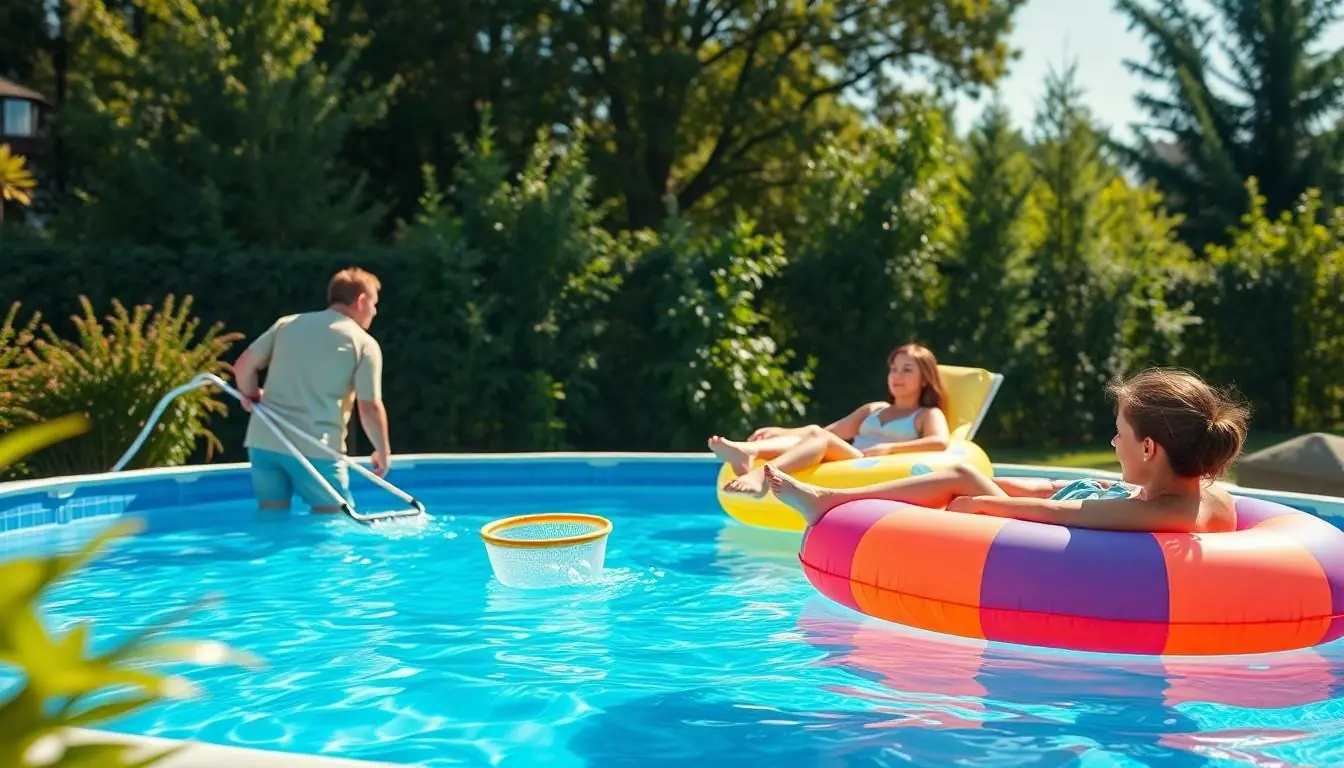When summer rolls around, nothing beats the joy of splashing around in your above ground pool. But wait! Before diving in, there’s a little matter of cleaning that can turn your backyard oasis into a swampy mess. Who wants to swim with a side of algae? Not anyone with a sense of humor or hygiene.
Table of Contents
ToggleOverview of Above Ground Pool Cleaning
Cleaning an above ground pool involves various tasks that ensure safe and enjoyable swimming. Regular maintenance prevents algae buildup, debris accumulation, and water clarity issues. Steps to keep it clean include skimming the surface, vacuuming the bottom, and brushing the walls.
Maintaining the water’s chemical balance is crucial. Checking pH levels regularly, adjusting chlorine levels, and adding algaecide when necessary prevents contamination. Water testing kits provide accurate readings, helping to maintain optimal conditions.
Filter systems play a vital role in pool cleanliness. Running the filter for at least 8 to 12 hours daily helps remove small particles and circulating water. Cleaning or replacing filter cartridges every few weeks enhances efficiency and prolongs the filter’s lifespan.
Additional tools aid in cleaning efforts. Using a wall brush dislodges dirt from pool walls, while automatic vacuum cleaners save time. Leaf nets capture larger debris, simplifying the cleaning process.
Seasonal preparations are also important. At the end of summer, properly closing the pool involves cleaning it thoroughly, adding winterizing chemicals, and using a pool cover. This minimizes the need for extensive cleaning when re-opening the pool in warmer months.
For expertise, consulting professional pool services can offer valuable insights. They provide specialized equipment and knowledge that can streamline the cleaning process. Overall, a consistent cleaning routine keeps an above ground pool inviting and in good condition.
Types of Above Ground Pools

Above ground pools come in various types, each offering unique features. Understanding these types helps in choosing the right one for a cleaning and maintenance routine.
Inflatable Pools
Inflatable pools are easy to set up and take down. Made from durable materials, they provide a quick solution for summer enjoyment. Users often appreciate their affordability and portability, which makes them a popular choice. Cleaning these pools involves regularly removing debris with a skimmer and ensuring proper water balance. It’s crucial to monitor chemical levels to avoid algae growth. In addition, inflatables require proper storage during colder months to extend their lifespan.
Rigid Frame Pools
Rigid frame pools feature a sturdy design that enhances durability. Constructed from steel or resin frames, these pools withstand a variety of weather conditions. Their installation process might involve more effort compared to inflatable options, but the long-term investment offers benefits. Regular maintenance includes checking the filtration system, skimming the surface daily, and vacuuming the pool floor weekly. Additionally, maintaining proper chemical levels ensures clear water and prevents algae. Rigid frame pools provide a balance between convenience and durability, making them a solid choice for pool owners.
Essential Cleaning Tools and Supplies
Selecting the right cleaning tools and supplies ensures an above ground pool remains pristine and inviting. Regular use of these tools contributes to efficient maintenance and a pleasant swimming experience.
Vacuum Cleaners
Vacuum cleaners designed for pools effectively remove dirt and debris from the bottom. Manual vacuum cleaners require the user to guide the unit, making them ideal for precise cleaning. Automatic vacuum cleaners operate independently, saving time by navigating the pool floor on their own. Both types help maintain water clarity and cleanliness. When choosing a vacuum cleaner, consider compatibility with the pool’s size and shape for optimal results.
Skimmers and Nets
Skimmers and nets play a vital role in surface cleaning. Skimmers effortlessly remove leaves, insects, and floating debris, enhancing water quality. Telescoping nets assist in reaching distant areas of the pool for thorough cleaning. Types of skimmers range from handheld models to integrated options attached to pool walls. Using these tools daily keeps the surface clean and reduces the accumulation of debris.
Brushes and Chemicals
Brushes aid in scrubbing pool walls and floors to eliminate algae and buildup. Different brush types, including nylon and stainless steel, serve specific surfaces, ensuring effective cleaning. Chemical maintenance is equally important for water balance. Chlorine tablets, shock treatments, and algaecides help maintain clean water and prevent algae growth. Regularly inspecting and adjusting chemical levels protects both the pool structure and user safety.
Cleaning Techniques for Above Ground Pools
Effective cleaning techniques for above ground pools ensure a pleasant swimming experience. Regular attention to these methods prevents issues like algae growth and cloudy water.
Manual Cleaning Methods
Manual cleaning methods involve hands-on approaches that effectively maintain pool clarity. Using a skimmer net, operators remove leaves and surface debris daily. Skilled owners often vacuum the pool floor weekly, ensuring dirt does not settle. Additionally, brushing pool walls aids in dislodging algae buildup. Regularly checking chemical balance remains essential during manual cleaning. Owners often adjust pH levels and chlorine to promote water safety.
Automated Cleaning Solutions
Automated cleaning solutions provide convenience and efficiency in maintaining pool hygiene. Robotic pool cleaners navigate autonomously, collecting debris from the floor and walls. These devices work on a schedule, minimizing the need for manual intervention. Suction and pressure-side cleaners connect to the pool’s filtration system, offering alternate options for busy pool owners. Consistent use of automated cleaners helps maintain clear water and reduce maintenance time. Investing in quality automated cleaning solutions ensures long-term cleanliness and health of the pool environment.
Maintenance Tips for Longevity
Maintaining an above ground pool extends its life and enhances enjoyment. Implementing a proactive approach in cleaning and water management is essential for keeping the pool in top condition.
Regular Cleaning Schedule
Establishing a regular cleaning schedule prevents debris accumulation and algae growth. Skimming the surface daily removes leaves and insects that can spoil the swimming experience. Vacuuming the bottom at least once a week ensures dirt and other contaminants don’t linger. Additionally, brushing walls weekly helps dislodge algae and keeps surfaces clean. Consistency becomes key in maintenance efforts; it ensures the pool remains inviting and comfortable all summer long.
Balancing Water Chemistry
Regularly balancing water chemistry protects swimmers and pool materials alike. Testing pH levels at least weekly promotes safe swimming conditions. Ideal pH levels should range between 7.2 and 7.8. Adjusting chlorine levels regularly helps eliminate harmful bacteria and keeps water clear. Using algaecide as needed control algae growth effectively. Maintaining these levels minimizes the risk of skin irritation and prolongs the lifespan of the pool.
Maintaining an above ground pool is essential for ensuring a clean and enjoyable swimming experience. Regular cleaning routines and proper chemical balance keep the water clear and safe for everyone. By investing in the right tools and establishing a consistent maintenance schedule, pool owners can significantly reduce the time and effort needed for upkeep.
Whether opting for manual methods or automated solutions, each approach contributes to a healthier pool environment. With a little dedication and the right strategies, enjoying a pristine above ground pool throughout the summer becomes a reality. Prioritizing cleanliness not only enhances the swimming experience but also extends the life of the pool itself, making it a valuable asset for years to come.



